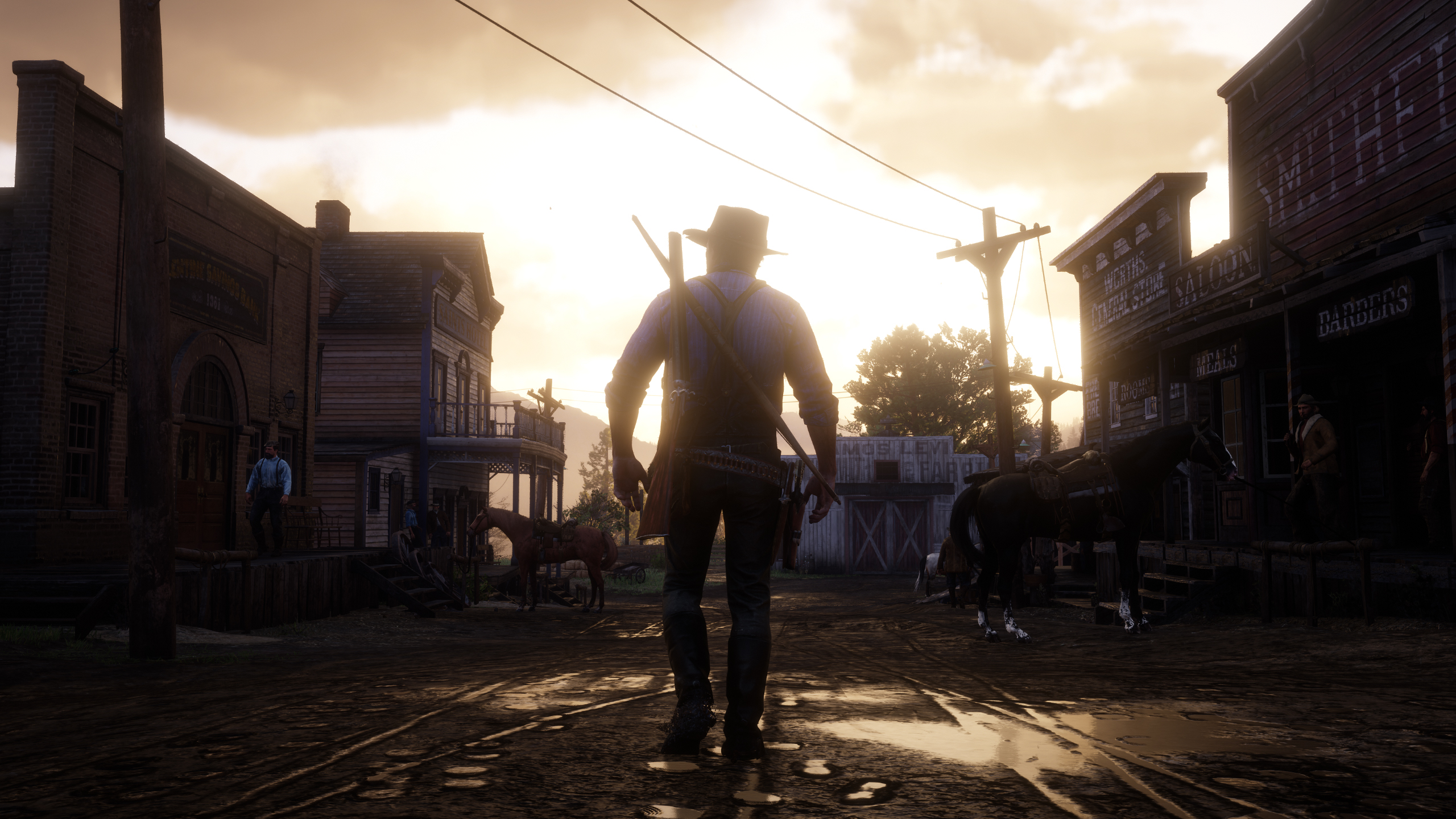What is it? An open world western drama
Expect to pay: $60
Developer: Rockstar Studios
Publisher: Rockstar Games
Reviewed on: RTX 2080, i9-9900k, 32 GB RAM, SSD
Multiplayer?: 4-player groups, competitive & co-op modes
Link: Official website
“Oh Jesus Christ, what have you done?” ThomasChen978 wants to know why a dozen bodies and a couple horse corpses are piled onto the train tracks bordering the early industrial town and New Orleans stand-in St. Denis. “You just murdered half the village.”
“No,” I reply, “That’s us. This is us. These are our bodies.”
We’re on round two of growing the recursive corpse pile. My posse got the idea to jump in front of the train after a few rounds of Lasso Your Friends And Toss Them Into The Sea with a couple friendly strangers. Red Dead Redemption 2, like GTA 5, has its own bowling minigame, we explain to Chen in a roundabout way, his horror inverting into blissful awareness. Die in Red Dead Redemption 2’s shared open world and you’ll respawn fast enough to carry your own corpse around.
The guy lines up with us. We must make it bigger. As the train comes around again, another posse tries to take us out. Chen defends us, but doesn’t make it back to the tracks. He falls a few paces away, screaming. A true warrior’s death.
Red Dead Redemption 2 can be the biggest, dumbest videogame ball pit for impulsive children, a harrowing story about the forced dissolution of community, or simply a serene and contemplative hiking simulator. It’s just about whatever you need it to be, and good at it too.
Just hours before corpse-bowling I went on a solo hike through snowy forests, stepping in the long shadows cast across the snow by the rising moon. I heard the clap of a gunshot in the distance. Some wolf tracks marked the snow in the same direction. I followed them to see who won. Anytime I pay attention and look closely, RDR2 rewards my curiosity.
The mind-boggling detail making up the massive world of RDR2 speaks to the creative force of a development team with an acute, obsessive dedication to realism (and all the money and time necessary to make it happen). Like how my friends’ characters flinch when I fire a gun near them, how animal carcasses decompose over time, how NPCs react to a muddy or bloody outfit accordingly, how busting through a doorway scares everyone on the other side.
It’s hard to believe RDR2 is so deep and wide and is also a cohesive, playable thing. I already knew it from playing days worth of the console version. It’s why I’m especially disappointed it debuted on PC in a somewhat busted state.

For every unrehearsed multiplayer adventure, there are a couple disconnects or crashes to desktop. Rockstar’s best story and characters yet intermittently filtered through a slideshow of frame hitches and freezes, finally addressed over a week after launch.
RDR2, the best western game and one of the best open world games I’ve ever played released with enough stability issues to make it a difficult recommendation until everything is completely smoothed out.
Morgan trail
Every pretty vista is something to lose through Arthur’s eyes.
Red Dead Redemption 2’s story mode follows the dying days of the wild west. The spreading industrial world encroaches on Arthur Morgan’s small band of outlaws and social underdogs, an imperfect but loyal, loving, and self-sustaining community.
Capitalism is reducing humans to their value as resources. Indigenous Americans are driven from the plains to make way for ‘civilization’ and commerce. Forests are brought down for lumber, the hills gutted for coal, and Morgan’s chosen family is caught in the middle of it all, forced to run, assimilate, or respond with violent protest. They do all three.
This is Rockstar’s most serious drama yet, and it’s really, really long. The story ‘ends’ after 40 to 50 hours if you’re rushing, and then continues for another 10 to 15. Red Dead 2’s main story missions are stubbornly typical Rockstar fare: ride to a destination talking all the while, do a tightly scripted albeit amusing thing, ride and chat to a final destination to finish up.
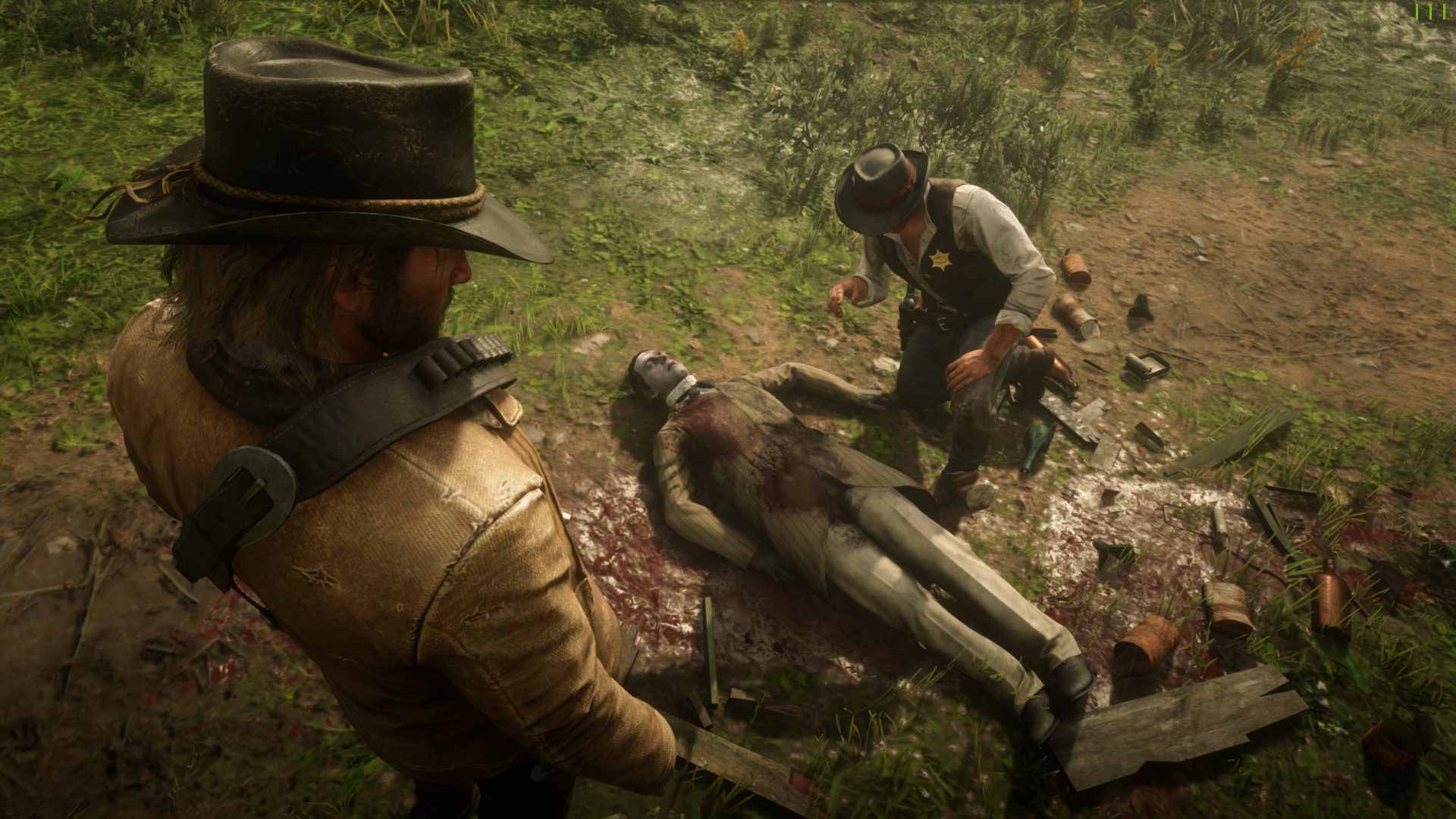
Missions are often thrilling action sequences or hypnotically mundane portraits of ranch labor and trade, peppered with cutscenes, long winded bespoke animations, and excellent performances. They’re just frustratingly rigid, to the point where it feels like I’m following stage directions rather than roleplaying the life of a vagabond in the old west.
Step out of line in these missions and it’s a failstate. In stark opposition to Red Dead Online, there’s little in them that encourage players to think for themselves, each designed to serve the story foremost. The RDR2 show is a great one at least, luxuriating in the slow pace of life in the old west.
It’s not all life-and-death dramatics; my favorite missions involve shoveling shit, getting drunk with a friend, the resolution of old romance, and a hot air balloon ride. Working through the more rote, stringent tasks is worthwhile in the end anyway, bolstered by exceptional, ambient world-building and characterization.
Side missions, minigames, small activities, and random world events—whether hunting down legendary gunslingers, catching a play, or stumbling across a woman stuck under a horse—all inform Arthur’s character and the setting in subtle, enriching ways.
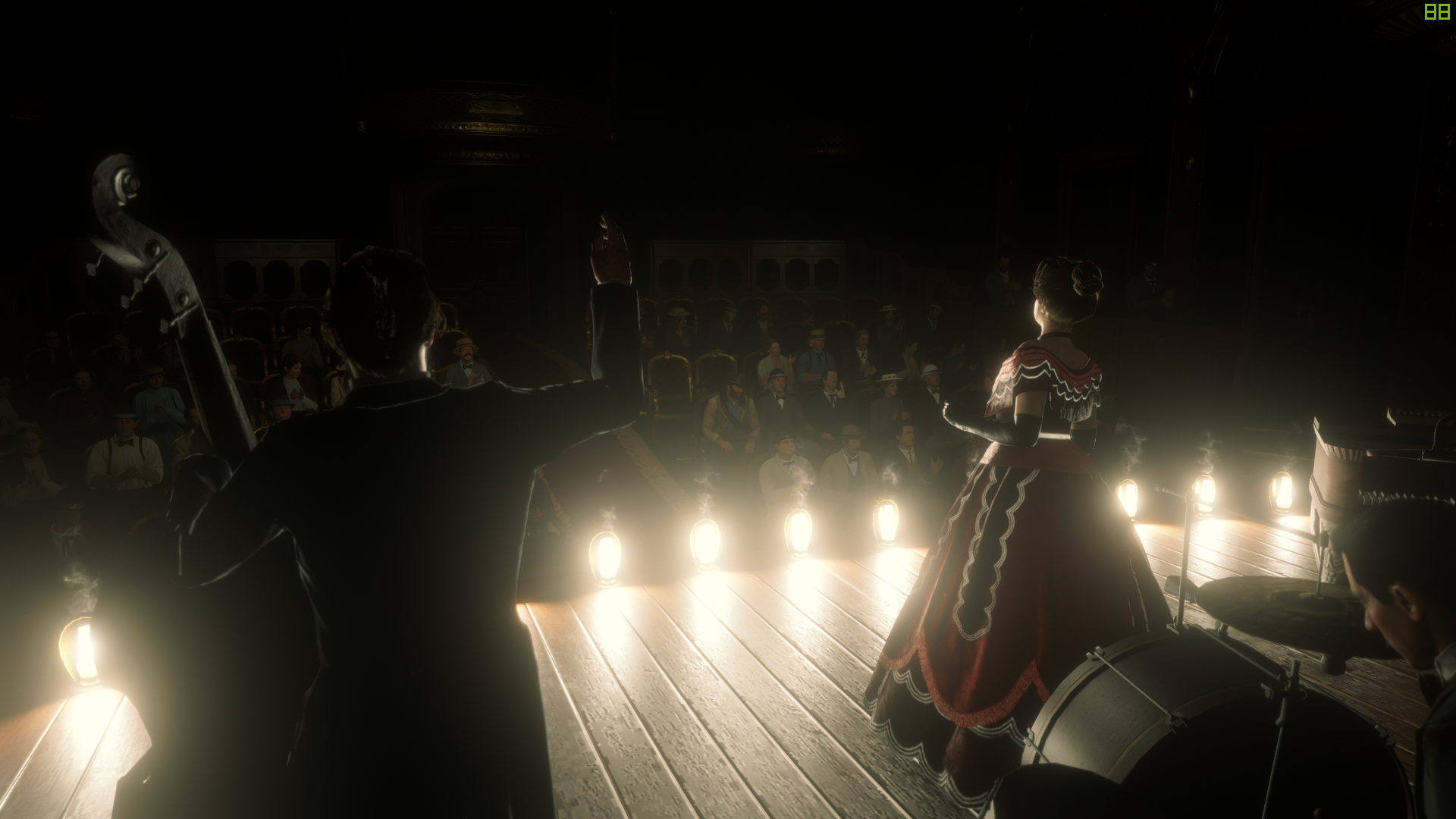
Nested in the third act of a fully animated and voiced theatrical performance, something like 10 minutes in, it’s possible to press the react button after a performer does a bit involving a telephone. Arthur will shout, “The hell with the telephone!” It’s an optional activity, a long one, and reacting in that short window is a choice. I have to imagine most players will miss it, but it’s there instead of Canned Response 1 through 3, because it’s something Arthur would say, a grumpy goofball righteously set in his ways.
God damn is it sad. An apocalypse that led to this.
He’ll write whole, actual diary entries about the 50 hour campaign, sketching memorable scenery and reflecting on the state of affairs of his chosen family, people he once knew, oscillating between hope and despair as his fortunes change. It’s entirely optional reading, but a refreshingly intimate take on a traditionally masculine figure who harbors as many doubts and hopes as the next person.
He’ll sing to himself on lonesome rides and decry his aging body in the mirror. He’ll have a rambling conversation with the horse-pinned woman as he gives her a ride to town, the two commenting on the troubles of working for rich, ungrateful men as a growing necessity. I feel it all.
Hillbillies might hold him up after making camp, a couple might attempt to rob him after inviting him over for dinner, a man with a snakebite might come stumbling out of the woods asking him to suck the poison out. These random encounters depict the brutal life on the fading frontier, as nature pushes back against the interlopers who seek to transform it. Arthur is a perfect vessel to see it through.
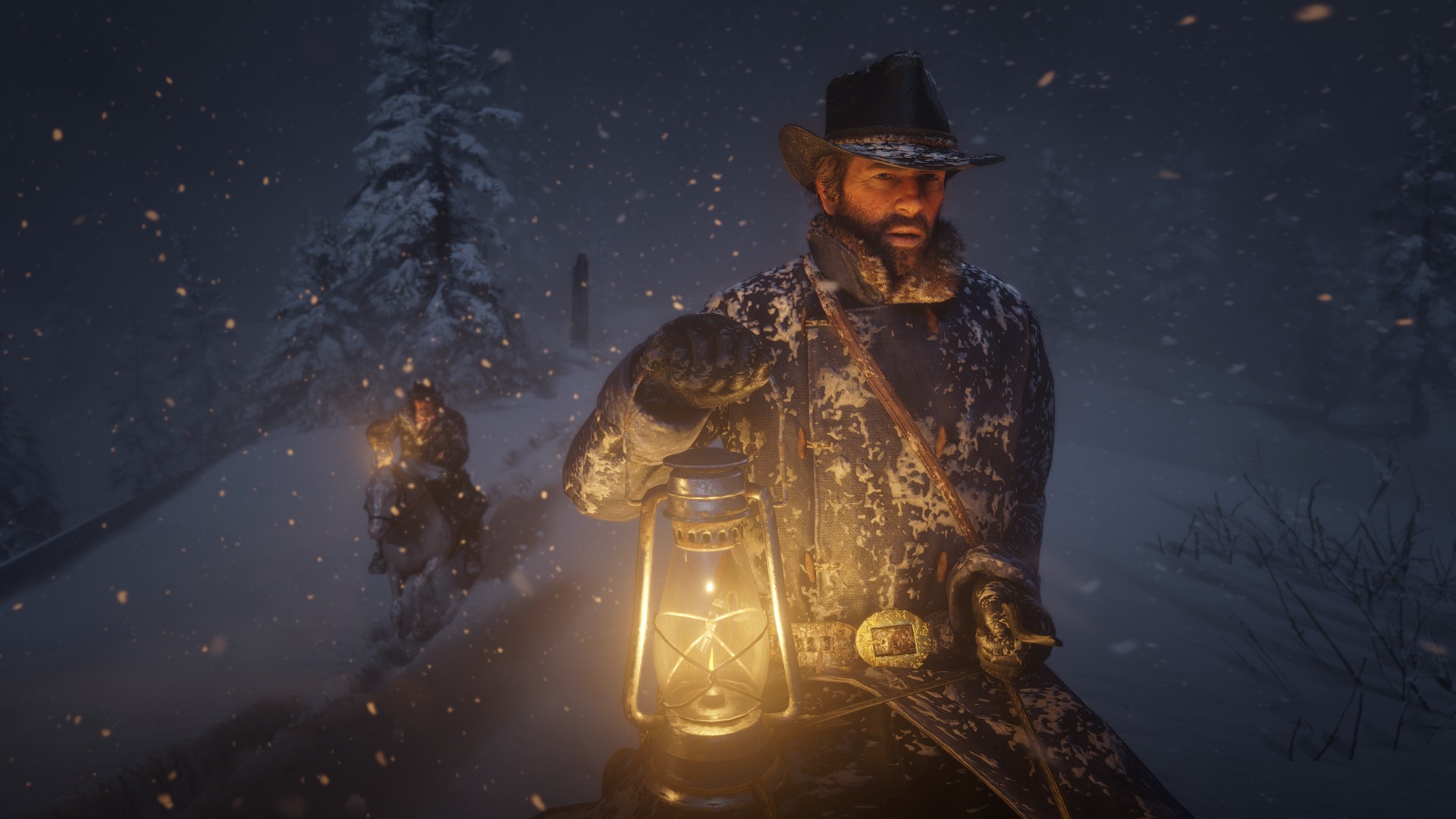
It’s because Arthur Morgan is one of the most deeply human characters I’ve played in a game, cruel and kind according to distinct principles carved out during a great turning point in American history.
The game world, beautiful as it is, is made more beautiful and tragic in how it’s propped up to play off him at every opportunity. Every pretty vista is something to lose through Arthur’s eyes, cut through by power lines and train tracks, the skies and his remaining life slowly filling up with factory smoke. Just about everyone sees an unhappy ending in RDR2, too. It’s a story I might not retain every moment of, but I won’t forget its brutal arc or the man in the middle of it all. God damn is it sad. An apocalypse that led to this.
Ren Der Reflection
I’m desperately trying to get an artful picture of the silhouette of my horse shitting against the moon.
Assuming you’re capable of running it at higher settings, RDR2’s greatest strength is in how it exquisitely renders the old west setting on PC, drawing more attention to the finer details that make it up. It’s one of the best looking games I’ve seen, and a rare experience that justifies a new GPU or CPU.
Improved draw distances and added vegetation detail at greater distances make some vistas look photographic. Long shadows transform walks or rides between locations from chores to lovely nature tours. Blemishes from animal attacks, bullet holes, rain, mud, or blood mark up clothes in sharp detail thanks to much higher resolution textures, telling little stories about what your friends have been up to.
A new photo mode makes it easy to share those moments of awe. As the kind of player who goes on hikes in RDR2 just for the sights and sounds, it’s a vital feature. I’m desperately trying to get an artful picture of the silhouette of my horse shitting against the moon, yet another self-appointed goal afforded by this ridiculously massive, intricate game.

With a 2080, i9-9900K, and 32GB of RAM, I can run RDR2 on mostly ultra settings with a few resource-intensive settings turned down or switched off completely. But some hardware combinations are proving troublesome for RDR2, leading to random crashes in certain APIs and, up until a recent hotfix, major hitching issues for some 4-core CPUs.
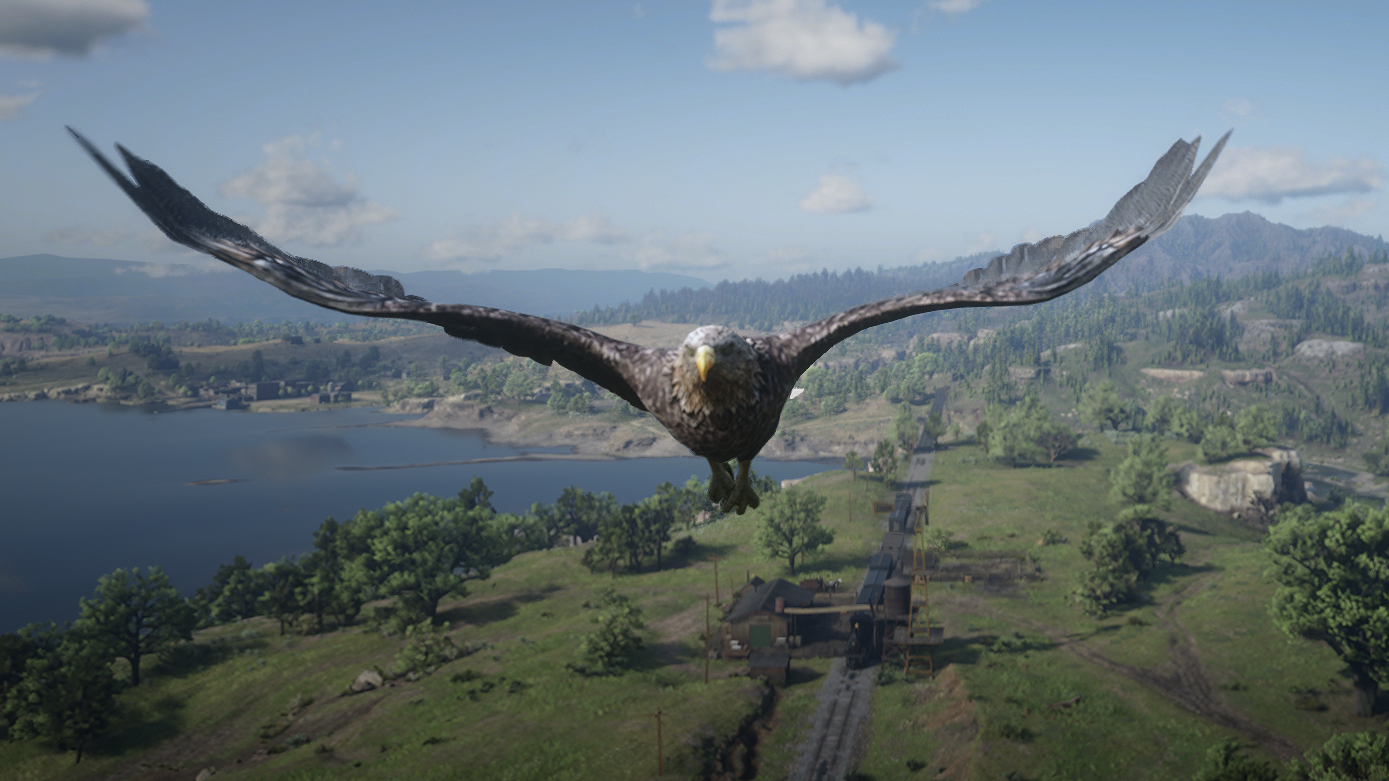
For all that good data, check out our initial benchmarks and performance analysis.
I couldn’t spend more than an hour playing without crashing to desktop during the first weekend, though switching from DX12 (which gives me better framerates) back to Vulkan stabilized things. Sometimes the UI bugs out and I can’t choose a select or purchase option, the map fails to appear, or I get unexpectedly punted from the game servers.
The graphics settings are almost too numerous as well, and perhaps misleading. In our testing, only a handful of settings affected performance more than 1-2 percent. The big remainders, MSAA, volumetric lighting, and parallax occlusion mapping among them, affect performance from 5 to 25 percent. Most of them don’t make big visual differences anyway and are best left off.
The way the settings are presented feels underdeveloped: a massive list with vague presets that require tinkering to get RDR2 running at a satisfying framerate. It’s daunting. The PC should be the best place to play, not the best place to play, eventually, after a few patches. A shame for a game this good-looking.
Cowboy poetry
There wasn’t much actual fishing to be had in our fishing trip, but I’ll take a memorable moment of stupidity, a cute little pocket of drama and action, over any amount of trout.
Just as in the singleplayer mode, in Red Dead Online I can reasonably make up my own goals and see them through. Problem is, it’s fundamentally hamstrung by a frustrating multiplayer leveling system that locks basic tools and cosmetics behind tall XP requirements that can take hours, maybe days, to meet.
The alternative is spending gold, the premium currency, to unlock items and clothes immediately. A fishing pole isn’t available until level 14. A damn fishing pole in The Outdoor Recreation Game. It’s not a great look and a terrible way to get players invested.
But once I waded through the bureaucracy of progression systems and filled out a basic suite of tools (fishing rod, bow, varmint rifle, nice hat, etc), Red Dead Online opened up wide. I’ve largely ignored the traditional matchmaking modes like gunfights and horse races, cheap thrills I’d rather play much better versions of in different games, opting to make my own fun. It’s led some of the most inventive, serene, surreal, and outright dumb adventures I’ve had in some time.
Chris Livingston and I set out to go fishing, just because. Fish are pocket change if sold to butchers and cooking them restores health and stamina, but, like the best bits of RDR2, fishing is just fun for the sake of it. A nice virtual day on the water partaking in the philosopher’s sport. Sounds nice.
After tossing an innocent into the water for his boat, we get curious if we can hitch a ride on one of the big shipping boats in the distance, uncertain whether it’s a physical object or the just videogame scenery to be seen but not touched. We take off from Turkey Island (so many turkeys), and row like hell.
Our tiny boat scrapes the side of the big sucker and starts taking on water. Chris makes a daring leap and just grabs the edge of the deck. I flounder in the swift current—it’s all over, man—while Chris calls out from the side of the large vessel, disappearing around the bend.
There wasn’t much actual fishing to be had in our fishing trip, but I’ll take a memorable moment of stupidity, a cute little pocket of drama and action, over any amount of trout. RDR2’s open world is ripe with that kind of playfulness, completely borne from our curiosities and impulses and largely supported by the simulation.
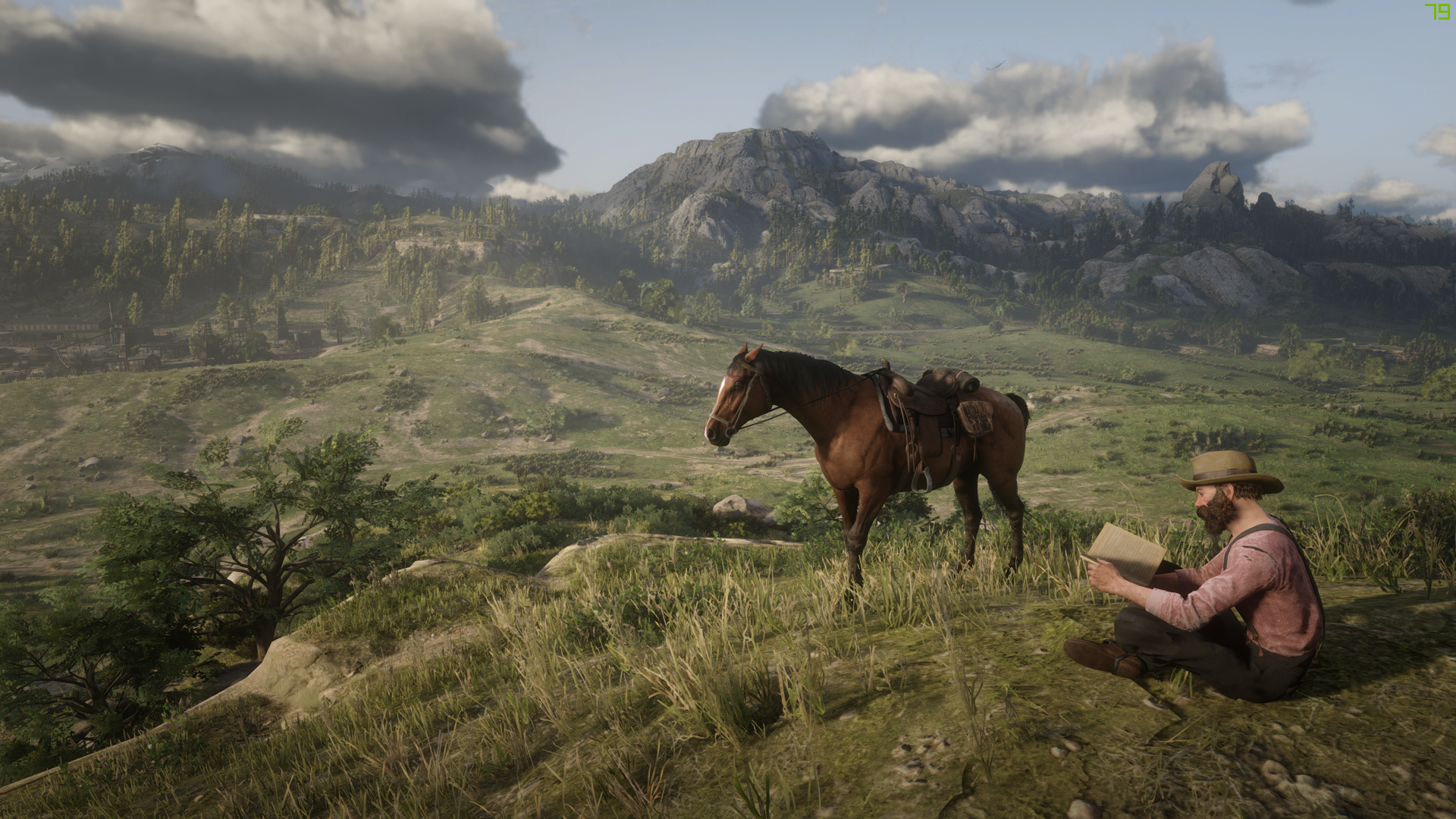
I once waltzed into the middle of a gunfight in Blackwater and carried player corpses to the church graveyard, one by one. Some posses caught on and attended the ‘burials’ of their friends. A corpse thanked me for the gesture. Later, in an extended streak of criminal activity, my posse and I captured another player and rather than murder them on the spot, we rode to the swamps and threw them in gator infested waters. I got the idea from doing the same thing to a friend.
On a less absurd note, I set myself the ongoing goal of earning enough money strictly from hunting to purchase cold weather gear and a fine rifle. I’m going to hike into the mountains and find the finest grizzly bear hide there is, becoming a wizened mountain man adorned with animal skins with a beard that nearly touches the floor.
In the meantime, I’m stopping city-wide gunfights by running through the streets and calling for a parley. I’m taking part in eight-player barroom brawls. I’m living the life of a normal cowboy in the best cowboy game there is. I just hope it cleans up soon.
Check out PC Gamer’s list of the best open world games for more massive adventures.
